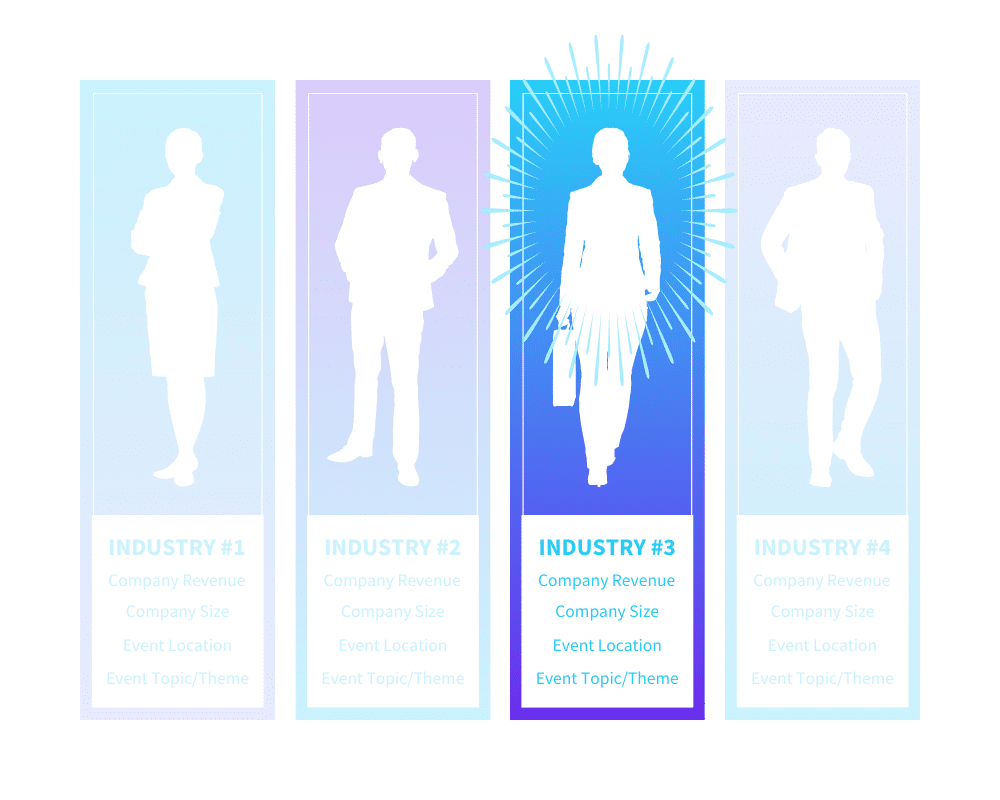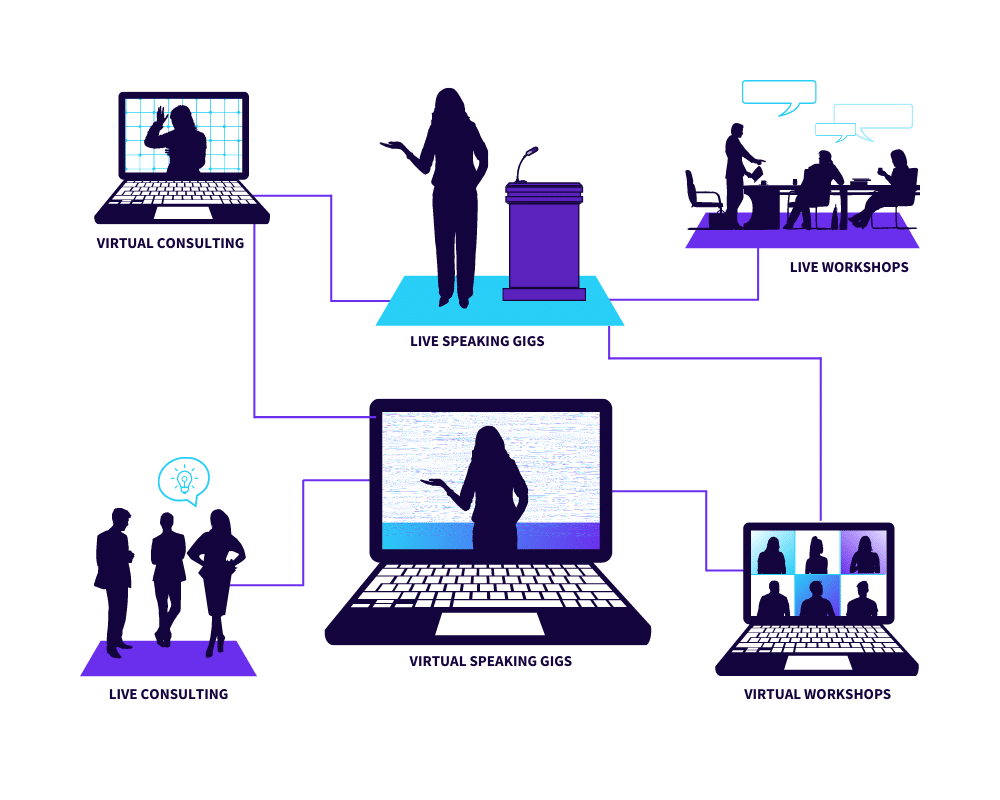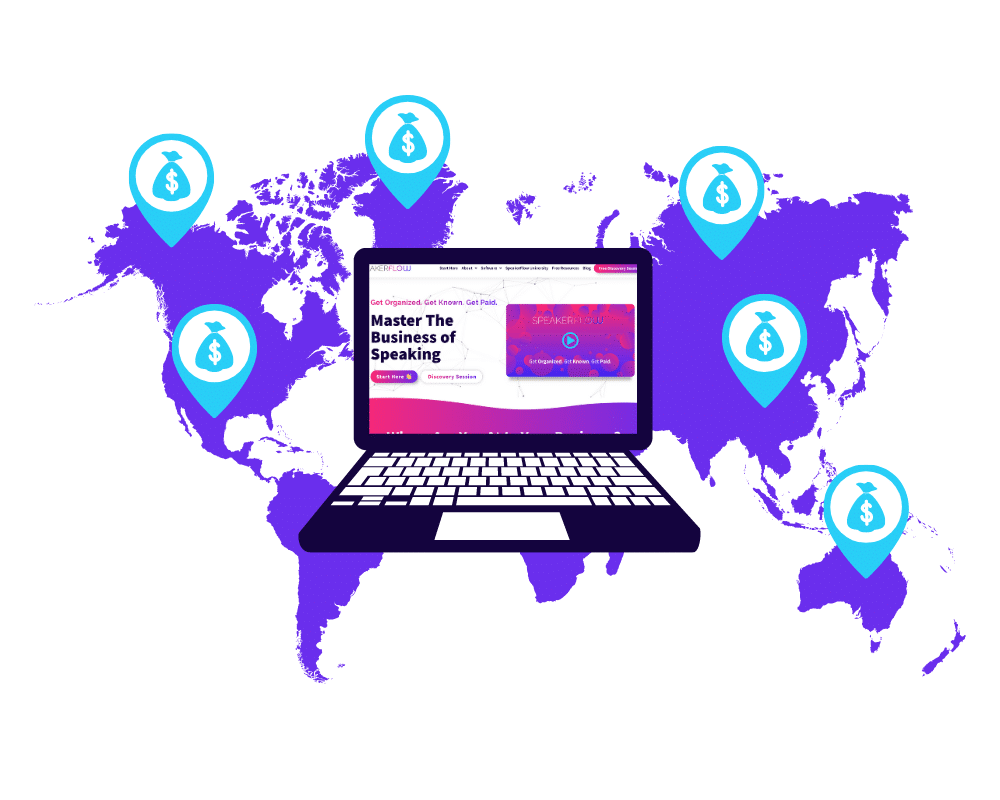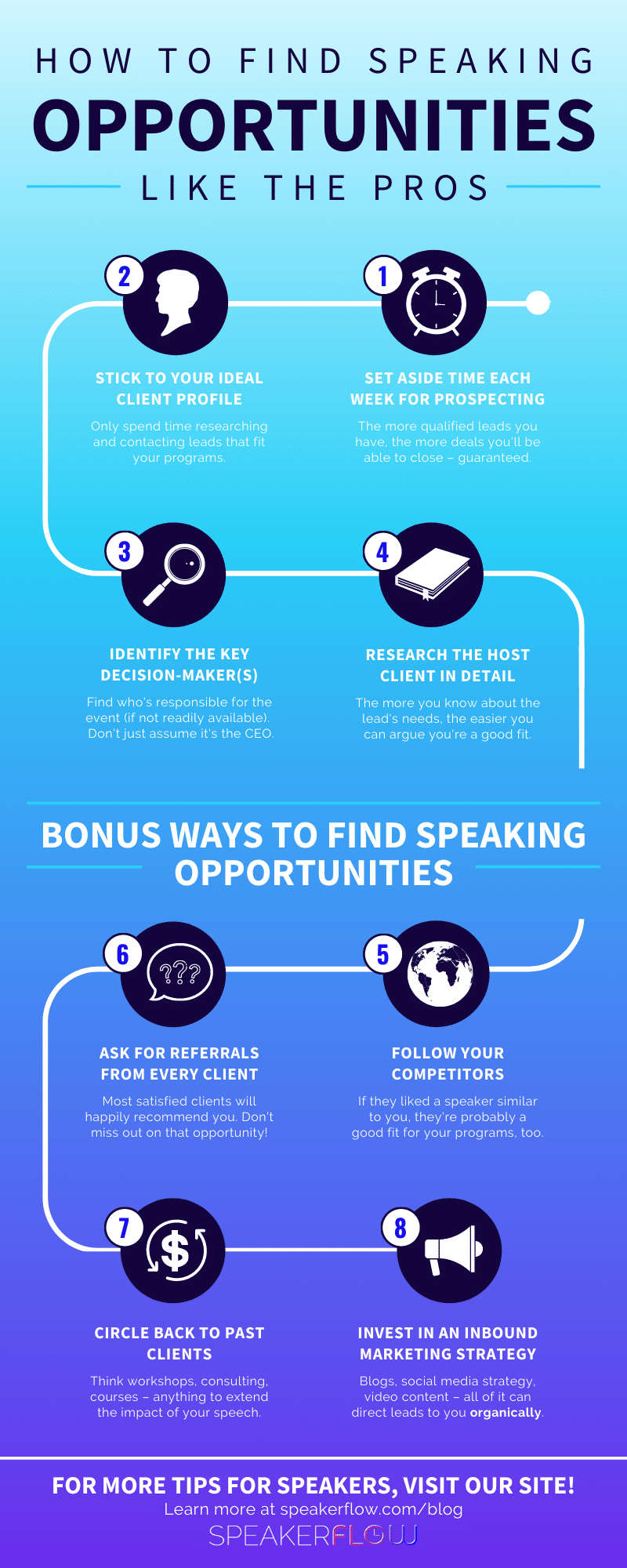Among professional speakers, it doesn’t take much to see the gap between those who have experience in the industry and those who are still climbing the ladder. For the former, revenue is relatively predictable. For the latter, every aspect of their speaking business – finding speaking opportunities, diversifying their income, you name it – comes with challenges, and creating predictability is an ongoing battle. That’s what we’re here to talk about, specifically how to find leads for your speaking business as efficiently as possible.
Within the SpeakerFlow team, we live and breathe the “four P’s” when it comes to speaker sales: Process + Prioritization = Predictability and Profit. We’re also advocates for taking a multifaceted approach to sales. Rather than relying on referrals, for example, we recommend conducting your own outreach, so you can ensure predictable profit every year.
That said, we also understand that without a process for prioritizing your tasks, reaching out to even a few people at a time can be overwhelming. So, to get the inside scoop, we met with dozens of experienced speakers and compiled their recommendations. The result was the four steps below, all of which came up time and time again in our conversations. Plus, we follow them ourselves, so we can personally attest, as a team, that they work. 😊
But, background info aside, let’s get into the details!
Finding Speaking Opportunities With Outbound Sales
Although, ideally, part of your speaking revenue comes from referrals, all successful speakers start building a steady flow of leads in the same way: reaching out on their own. In total, this process – outbound sales – consists of a variety of strategies for connecting with potential customers. Think phone calls, emails, or LinkedIn messages.
For each of these communication channels, the key is consistency in your process, your prospecting, and your research. When carried out consistently and thoroughly, these elements combine to communicate your value, as a thought leader. This makes the decision-maker in your inbox immediately inclined to hire you. Below are the four key steps to making that happen.
1. Set aside time each week for prospecting.
First, allocate time every week for prospecting for new leads. In many ways, sales in any industry is a numbers game, meaning that the more leads you have in your pipeline, the greater the number of opportunities will come of them. In the speaking industry, the same is true. Even if you’re an experienced salesperson and speaker, the more event planners you can connect with each week, the more likely you’ll get booked.

Admittedly, if you’re like me, the idea of looking for leads isn’t the nicest thought in the world. You may even be thinking right now, “Do I really have to do that every week?” To answer your question, yep! It doesn’t have to be every day, either. Setting aside as little as a couple of hours each week to look for upcoming events can mean the difference between struggling for speaking engagements and regularly getting on stage.
To start prospecting, there are a few tips and tools to keep in mind. Below are our team’s favorites.
- Tip #1: Keep it simple. This part of the sales process isn’t about selling, so all you have to do is find basic event information. We’ll get into greater detail later.
- Tip #2: When in doubt, look for live speaking opportunities in your local area or virtual ones in your focus industry. Even if you’re a new speaker, building a base with small businesses can help you gain experience and testimonials to win over bigger deals in the future.
- Tool #1: Use our free revenue calculator, if you’re unsure how many leads you need to find and sales you need to close to hit your revenue goals.
- Tool #2: Use the Intel Engine to quickly and easily pull Google results for upcoming events, listed by industry, location, date, etc.
2. Stick to your ideal client profile.
Next, after finding your list of speaking opportunities, look to your ideal client profile or ICP. If you haven’t defined an ICP before, it’s essentially a set of criteria for each of your speaking clients. These can include things like how much they pay their speakers, how long their events last, and how many employees are staffed by their organization. Most importantly, your ICP includes the niche(s) on which you focus your speaking materials. We recommend a maximum of three, to start, but you can always iterate or add to them, as you gain more experience about which groups benefit most from your message.

Ultimately, by sticking to your ICP, you ensure that you’re spending time on worthwhile leads, and you increase the likelihood that your sales efforts will pay off. To define your ICP, if you don’t already have one, start by answering the following questions.
- What type of events do you want to speak for (conferences, corporate meetings, etc.)?
- Which industries do you want to focus on (finance, health care, education, etc.)?
- How large are the companies or organizations that you want to hire you?
Once you’ve defined your ICP, weed out any speaking opportunities that don’t exactly fit it. One of the biggest mistakes speakers make is trying to go after a ton of different industries at once, especially for those that speak on a broad topic, such as customer service. However, by doing this, you dilute your message, as it has to be broad enough to suit a wide variety of audiences. To avoid this, instead of trying to please as many people as possible, the more efficient way to get booked is to define who you serve. Then, tailor your speaking materials to suit that audience, so they can’t say no.
3. Identify the key decision-makers for each event.
After defining your ICP – and making sure your speaking opportunities list matches it – the next step is finding the decision-maker for each lead in your list. Depending on the event in question, the role of the decision-maker may vary. For a corporate conference, for example, the decision-maker may be an event planner, contracted specifically for that event. On the other hand, for an educational event, such as guest speaking at a high school, the decision-maker is more likely to be a permanent staff member like the principal or superintendent.

To make it easier to pinpoint the decision-makers or your list, start by looking at your past speaking engagements. Were the people that hired you executives, vice presidents, or managers? Maybe they were directors of education, event planners, or certified meeting professionals (CMP)?
Regardless of the event, when looking for the decision-maker, the most important thing to remember is to be detailed. Don’t simply bypass the chain of command and go right to the CEO. Not only will they likely brush off your emails. They could also feel like you’re spamming them and not taking the time to personalize your outreach and respect their position. Instead, look for the specific individual listed as responsible for the event, so you can customize your messaging when you reach out to them.
Though this may seem time-consuming at first, identifying the key decision-maker will get easier the more you sell. In fact, as long as you’re tracking the roles of the contacts that hire you, over time, you’ll be able to see consistency in the decision-makers you should look for in future prospecting. In other words, the more data you collect before, during, and after each event, the better you’ll be able to prepare down the line.
4. Research as much as possible about the host company and/or individuals.
Finally, after finding a list of speaking opportunities and the people responsible for them, the last pre-sales step is research. Like preparing for an interview or exam, gearing up for a sales conversation is all about sorting the information you need from the details that will ultimately get in the way of your point. If you know a company has a strict budget, for example, you can assume that, even if you have a range of services that fit their needs, they’re going to opt for the one that best fits their financial plan. Likewise, if a company just went through a merger or acquisition, you can assume that team-building or change management programs will be an easier sell than a work/life balance program.

The amount of research you’ll need will vary depending on the event. However, there are a number of things you can assume are worth researching every time, all of which you can find in minutes with the Intel Engine, if not on the event web page.
- What is the overarching goal of the event (increased sales, motivated team, etc.)?
- Where, in recent news, has the company and/or people hosting the event appeared and why?
- What is the email, phone number, and LinkedIn profile URL for the decision-maker? How about for a second contact (in case the main decision-maker doesn’t respond)?
- Is there a budget listed for event speakers, and does it match up with your fees?
In short, for each lead in your list, your goal is to gather as much relevant information as possible. This not only helps you prepare for the sales call, so you can vouch for your value. It also demonstrates to the event organizer that you’re invested in their needs. You’re not just in it to make money.
Bonus Ways to Find Speaking Opportunities
At this point, we’ve covered the four most important steps to outbound sales. Beyond these, however, there are plenty of other ways to bring in revenue month over month. As you continue to grow your speaking business – and your number of referrals gigs grows – consider implementing one or more of these strategies to supplement your outbound sales efforts. That way, you won’t have to rely on a single source of leads for your income.
Follow in your competitors’ footsteps.
One source of speaking opportunities that is far too often overlooked is your competitors. For many professional speakers, it can be tempting to think of other speakers as completely noncompetitive. You may be thinking yourself, “Well no one speaks on exactly the same thing I do.”

But, even if you think that, there are undoubtedly speakers out there that tackle the same problems you do. If you’re a sales speaker, for example, you probably have your own unique angle on sales that makes you stand out. Nevertheless, there are thousands of other thought leaders that brand themselves as sales speakers, too, including Meridith Elliott Powell, Mark Hunter, Dr. Cindy McGovern, and Sam Richter, to name a few.
In the same way, in your focus industry, there are almost certainly speakers who fall into the same “category” as you. Maybe your presentation topics are identical. Maybe they’re just mildly similar. In either case, identifying your competitors allows you to gain insights into the processes – and clientele – of speakers like you, speakers you can easily imitate. Some insights to look for include:
- Places they’ve spoken recently. These are all opportunities for you to say, “Hey, I noticed you hired So-And-So. If you liked them, my programs may be useful, too!”
- Sales strategies they’re using. Think lead magnets on their website, the wording in their newsletter, even their personal brand.
- Speaking fees they’re charging. If your competitors are able to earn more than you, you might want to consider trying out some higher fees. Don’t sell yourself short!
To summarize, actor and producer Jake Gyllenhaal may have said it best: “The idea of competition, particularly in a creative atmosphere, is always there; if you don’t acknowledge that, you are doing yourself and the process a disservice.”
Always ask for referrals from past clients.
Besides following your competitors, another solid source of speaking opportunities, as we’ve touched on a few times, is referrals. For well-established speakers, referrals can come effortlessly. After all, the more clients you’ve served, the more people are likely to recommend you to other event organizers in the industry.

But it’s important to remember that you don’t need to be a world-class speaker to create referrals. If you’re an educational speaker, ask the principal (or decision-maker from the school) if they know of any other schools in the area that could benefit from your presentation. If you’re working corporate gigs, ask your client if any of their partners need to hear what you have to say.
All in all, the key is to be confident and frame your question as if you want to provide more value for them or someone affiliated with them. You need to demonstrate that you enjoyed participating in their event and want to extend your services to another person in their network. That way, not only do you “leave them wanting more,” so to speak. You also show that you value their word, that it would mean a lot for them to recommend you.
If you’re a new speaker, especially, build the habit of asking for referrals after every presentation. Even better, build a step into your sales process that reminds you to ask for a referral or, at the very least, a testimonial. On average, 68% of customers are more than happy to leave you a good review, and 93% of customers look at reviews before spending a dime. So, even if a client can’t refer any new clients directly, a simple ask can pay off big time, when future customers see their review.
Circle back to past clients for spin-off business.
Speaking of leaving clients “wanting more,” another way to find new speaking opportunities is to check back in with past clients for spin-off business. This can be any offerings that complement the content of your speaking programs, including those listed below.

- In-person or virtual consulting
- In-person or virtual workshops
- Executive coaching programs
- Online coursework and corresponding check-in meetings
- Print or audio books (with or without companion worksheets or workbooks to help them turn your book into action)
Overall, providing these options has a long list of benefits for you and your wallet. For one thing, because you’ve already demonstrated your skills, it takes much less time and energy to get a past client back on the hook than it does to pitch a new one. It’s also easier to sell a client on something they already have a piece of (i.e. your speech). If you gave a presentation on sales training, for instance, you can quickly and easily argue, “I also offer sales workshops, if you feel like you could use a hand in training your sales team.” To put it simply, they already have the motivation to implement your message. So, if your your additional resources and services make that implementation easier, purchasing them is a no brainer.
Like referrals, spin-off business depends on your client base. Consequently, for many new speakers, the thought of selling to clients more than once – or for a higher fee – can be daunting. If you’re in this boat, remember that as long as you leave a client happy at the end of your presentation, you clearly did your job well. Use that to your advantage and remember that sales isn’t really about money. It’s about supporting your clients and doing everything you can to help them succeed.
Invest in an inbound marketing strategy.

Last but not least, if you really want to beef up your list of speaking opportunities each month, invest in a detailed strategy for inbound marketing. Compared to outbound marketing (where you reach out to clients), inbound marketing is all about drawing leads to you. Essentially, it’s like a magnet, so that when a potential client searches for a speaker in your arena, they’re almost immediately directed towards your website or social media profiles.
In total, inbound marketing encompasses a ton of different projects. A few of the most commonly practiced in the speaking space include search engine (SEO) optimized blogs, SEO-optimized website pages, a regularly distributed newsletter, and regularly updated social content. Whatever the channel, the goal is to direct potential leads without interrupting their activity, like an advertisement would.
To learn more about setting up an inbound marketing strategy, check out our ultimate marketing guide or our beginner’s guide to multi-channel marketing, if you already have a content base to start with.
Additionally, if you don’t want to go it alone, no worries! Join SpeakerFlow University and master the business of speaking with a community behind you. From sales to operations to marketing, we – and other speakers – share resources and insights to help you grow a speaking business, just in less time than you’d need on your own. 👍







